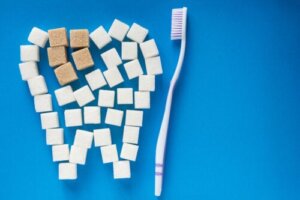Childhood Diabetes and its Relationship to Oral Health


Written and verified by the dentist Vanesa Evangelina Buffa
Childhood diabetes is a pathology that has an impact on several areas of the children who suffer from it, including oral health. This metabolic disorder affects a high percentage of the population and is most frequently observed during childhood and adolescence. In this article, we’ll explain the relationship between the disease and oral health and the oral issues related to this disorder.
According to the National Diabetes Statistics Report in 2020, 210,000 children and adolescents under the age of 20 had been diagnosed with diabetes in the United States. That is 25 out of every 10,000 youth.
What is childhood diabetes?
According to the National Institutes of Health (NIH), diabetes is a disease that occurs when blood glucose levels are too high. This is due to a problem with insulin. When the body doesn’t produce enough or doesn’t use it properly, the sugar remains in the blood and doesn’t reach the tissues. There are different variants of the disease:
- Type 1
- Type 2
- Gestational
- Monogenic
In general, childhood diabetes belongs to type 1. In this type of disorder, the child’s body doesn’t produce insulin because its immune system attacks and destroys the cells of the pancreas that produce it. Therefore, in order to survive, children have to use insulin every day. This allows them to maintain normal blood sugar levels and prevent metabolic complications.
Type 2 diabetes results from insulin resistance. In this case, the receptors aren’t sensitive enough for the hormone to bind to the cells and enter the glucose. In turn, studies report an increasing number of children and adolescents being diagnosed with this variant. This is possibly associated with the increase in childhood obesity, excess weight, and sedentary lifestyles.
Excess blood sugar
Excess glucose in the blood predisposes children to various health problems:
- Increased urine production
- Excessive thirst
- Weight loss
- Increased appetite
- Vision problems
- Growth deficiency
- Predisposition to infections

The relationship between childhood diabetes and children’s oral health
A study published in the journal Decisions in Dentistry considers that the relationship between childhood diabetes and oral health conditions in children is bidirectional.
- On the one hand, hyperglycemia increases inflammatory processes, alters defenses, predisposes children to infections, decreases tissue vascularization, and affects repair processes. Therefore, diabetes predisposes little ones to suffer from certain mouth conditions, such as gingivitis, periodontitis, cavities, and candidiasis, among others.
- On the other hand, suffering from certain oral problems worsens diabetes. This is because periodontal infections cause systemic inflammation that reduces the action of insulin in the cells and affects glycemic control.
Oral manifestations of childhood diabetes
The American Dental Association website explains that children with childhood diabetes are at increased risk for certain oral processes associated with hyperglycemia. These are the most common manifestations:
- Early dental eruption. Children with diabetes tend to lose their baby teeth prematurely and erupt permanent teeth at an earlier age than normal. According to a study in the journal Pediatrics, this sign may be a clue to early diagnosis of the disease.
- Increased risk of gum disease, such as gingivitis and periodontitis. Weak white blood cells, vascular problems, and exaggerated inflammatory responses hinder the gums’ ability to defend against bacteria in the mouth.
- Reduced saliva production. This causes discomfort and increases the risk of pain, burning tongue, ulcers, cavities, bad breath, and infections. Scientific literature explains that hyperglycemia decreases salivary flow, reduces its pH, and increases salivary glucose concentrations, which favors the proliferation of pathogenic bacteria.
- Taste dysfunction.
- Oral ulcers. Lack of collagen, immune deficiency, and difficulty in tissue healing increase soft tissue lesions.
- Cavities. Oral dryness and reduced tissue immune response increase the risk of this disease. Studies show that lesions increase in infants with poor metabolic control.
- Oral Candidiasis. The fungus takes advantage of high sugar levels and low immune response to proliferate and cause infection in the soft tissues of the mouth.
How to take care of the oral health of children with childhood diabetes
Due to the deterioration of salivary function and the increased risk of periodontitis and cavities, children with diabetes should receive special care. We’ll tell you about it below.
1. Control blood glucose levels
Most of the damage and complications that occur in a child’s oral tissues are related to high blood sugar levels. One of the best strategies to avoid oral health problems is to try to keep blood glucose levels close to normal.
Medical checkups are essential. Performing blood glucose tests and laboratory examinations will help you to know the levels of sugar in the blood. In addition, it’s important to be rigorous with the medication prescribed by the professional and combine this care with an adequate diet.
2. Maintain proper oral hygiene

Another way to take care of the oral health of your child with childhood diabetes is to take care of their oral hygiene. It’s advisable to clean your child’s teeth and gums three times a day with a soft-bristled toothbrush and fluoride toothpaste. In addition, you should complement hygiene with dental floss. Also, in older children, chewing gum with xylitol is a beneficial measure to increase salivary flow and reduce bacterial plaque.
3. Visit the pediatric dentist frequently
Visiting the pediatric dentist every six months is essential. In addition to check-ups, the professional will apply specific preventive measures that will help preserve your child’s oral health:
- Professional cleanings: These are important to control bacterial plaque, remove tartar, and prevent damage to periodontal tissues.
- Dental sealants: These help prevent the development of cavities.
- Fluoride topicals: Used to counteract the acidity of the oral environment and prevent oral diseases.
How to prepare a child with diabetes for a dental appointment
When you take your child to the pediatric dentist, it’s important that you inform the professional of everything related to your child’s metabolic problem. Therefore, you should indicate the values of the last laboratory tests, the medications your child takes, and all the information you consider relevant.
You should also inform them if your child has suffered episodes of hypoglycemia in the past, as they could happen again. To avoid these events, studies recommend scheduling appointments in the morning and after breakfast. In addition, if blood sugar levels aren’t well controlled, only dental emergencies should be tended to: Acute infections, abscesses, or trauma.
A healthy mouth for a better quality of life
To improve the quality of life of your little one with childhood diabetes, you should take care of their oral health. This condition predisposes them to suffer certain cavity problems, but with proper care, you’ll be able to counteract them. A healthy mouth will allow your child to perform oral functions normally and, at the same time, will help them control their blood sugar levels.
All cited sources were thoroughly reviewed by our team to ensure their quality, reliability, currency, and validity. The bibliography of this article was considered reliable and of academic or scientific accuracy.
- Abdulghafoor, R. (2020). Correlation of Glucose Levels in Serum and Saliva: Determination of Incidence of Dental Caries and Periodontal Status in Patients with Diabetes Mellitus. Al-Esraa university college journal for Engineering Sciences, 1. https://www.iasj.net/iasj/download/c17fcfdd0e403632
- American Dental Association (ADA). (s.f.) Diabetes and dental health. Consultado el 05/05/2023. https://www.mouthhealthy.org/all-topics-a-z/diabetes/
- Centros para el Control y Prevención de Enfermedades (CDC). (2020). Informe Nacional de Estadísticas de la Diabetes 2020: estimaciones sobre la diabetes y su carga en los Estados Unidos. https://www.cdc.gov/diabetes/pdfs/data/statistics/NDSR_2020_Spanish-508.pdf
- de Camargo, M. G. A., Bolívar, M., Giunta, C., & Mora, K. (2015). Manejo odontológico de pacientes pediátricos comprometidos sistemáticamente. Revisión bibliográfica. Revista de Odontopediatría Latinoamericana, 5(1). https://www.revistaodontopediatria.org/index.php/alop/article/view/12
- Rowe, D., Sohn,H. (2017). Oral complications in children with diabetes. Decisions in Dentistry. 3(4):46–49. https://decisionsindentistry.com/article/oral-complications-children-diabetes/
- Institutos Nacionales de Salud (NIH). (2016). ¿Qué es la diabetes?. Consultado el 05/5/2023. https://www.niddk.nih.gov/health-information/informacion-de-la-salud/diabetes/informacion-general/que-es
- Lal, S., Cheng, B., Kaplan, S., Softness, B., Greenberg, E., Goland, R. S., … & Lamster, I. B. (2008). Accelerated tooth eruption in children with diabetes mellitus. Pediatrics, 121(5), e1139-e1143. https://pubmed.ncbi.nlm.nih.gov/18450858/
- Valdés Gómez, W., Almirall Sánchez, A., & Gutiérrez Pérez, M. Á. (2019). Factores de riesgo de diabetes mellitus tipo 2 en adolescentes. Medisur, 17(3), 356-364. http://scielo.sld.cu/scielo.php?pid=S1727-897X2019000300356&script=sci_arttext&tlng=pt
- Wang, Y., Xing, L., Yu, H., & Zhao, L. (2019). Prevalence of dental caries in children and adolescents with type 1 diabetes: a systematic review and meta-analysis. BMC oral health, 19, 1-9. https://link.springer.com/article/10.1186/s12903-019-0903-5
This text is provided for informational purposes only and does not replace consultation with a professional. If in doubt, consult your specialist.








